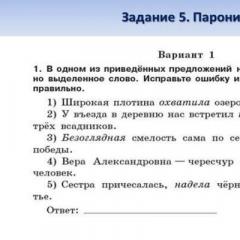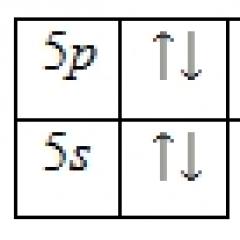Quadratic function and its properties. Topic "Increasing and decreasing quadratic function" Find by. Graphing a Quadratic Function
Quadratic function
Function f(x)=ax2+bx2+c, Where a, b, c- some real numbers ( a 0), called quadratic function. The graph of a quadratic function is called parabola.
The quadratic function can be reduced to the form
f(x)=a(x+b/2a)2-(b2-4ac)/4a, (1)
expression b2-4ac called discriminant square trinomial. Representation of a quadratic function in the form (1) is called selection full square.
Properties of a quadratic function and its graph
The domain of definition of a quadratic function is the entire number line.
At b 0 function is neither even nor odd. At b=0 quadratic function - even.
A quadratic function is continuous and differentiable throughout its entire domain of definition.
The function has a single critical point
x=-b/(2a). If a>0, then at the point x=-b/(2a) function has a minimum. At x<-b/(2a) the function decreases monotonically, with x>-b/(2a) increases monotonically.
If A<0, то в точке x=-b/(2a) the function has a maximum. At x<-b/(2a) the function increases monotonically, with x>-b/(2a) decreases monotonically.
Point graph of a quadratic function with abscissa x=-b/(2a) and ordinate y= -((b2-4ac)/4a) called the vertex of the parabola.
Function change area: when a>0 - set of function values [-((b2-4ac)/4a); +); at a<0 - множество значений функции (-;-((b2-4ac)/4a)].
The graph of a quadratic function intersects the axis 0y at the point y=c. If b2-4ac>0, the graph of a quadratic function intersects the axis 0x at two points (different real roots of the quadratic equation); If b2-4ac=0 (quadratic equation has one root of multiplicity 2), the graph of a quadratic function touches the axis 0x at the point x=-b/(2a); If b2-4ac<0 , intersections with the axis 0x No.
From the representation of a quadratic function in the form (1) it also follows that the graph of the function is symmetrical with respect to the straight line x=-b/(2a)- image of the ordinate axis during parallel translation r=(-b/(2a); 0).
Graph of a function
f(x)=ax2+bx+c
- (or f(x)=a(x+b/(2a))2-(b2-4ac)/(4a)) can be obtained from the graph of a function f(x)=x2 with the following transformations:
- a) parallel transfer r=(-b/(2a); 0);
- b) compression (or stretching) to the x-axis c A once;
- c) parallel transfer
r=(0; -((b2-4ac)/(4a))).
Exponential function
Exponential function called a function of the form f(x)=ax, Where A- some positive real number called the basis of the degree. At a=1 the value of the exponential function for any value of the argument is equal to one, and the case A=1 will not be considered further.
Properties of the exponential function.
The domain of definition of a function is the entire number line.
The domain of a function is the set of all positive numbers.
The function is continuous and differentiable throughout its entire domain of definition. The derivative of the exponential function is calculated using the formula
(a x) = a xln a
At A>1 function increases monotonically, with A<1 монотонно убывает.
The exponential function has an inverse function called the logarithmic function.
The graph of any exponential function intersects the axis 0y at the point y=1.
The graph of an exponential function is a curve directed concavely upward.
Graph of the exponential function at the value A=2 is shown in Fig. 5

Logarithmic function
The inverse function of the exponential function y= a x is called logarithmic and denote
y=loga x.

Number A called basis logarithmic function. A logarithmic function with base 10 is denoted by
and a logarithmic function with a base e denote
Properties of the logarithmic function
The domain of definition of the logarithmic function is the interval (0; +).
The range of the logarithmic function is the entire numerical range.
The logarithmic function is continuous and differentiable throughout its entire domain of definition. The derivative of a logarithmic function is calculated using the formula
(loga x) = 1/(x ln a).
A logarithmic function increases monotonically if A>1. At 0<a<1 логарифмическая функция с основанием A decreases monotonically. For any reason a>0, a 1, equalities hold
loga 1 = 0, loga =1.
At A>1 graph of a logarithmic function - a curve directed concavely downwards; at 0<a<1 - кривая, направленная вогнутостью вверх.
Graph of logarithmic function at A=2 is shown in Fig. 6.

Basic logarithmic identity
Inverse function for the exponential function y= a x will be a logarithmic function x =log a y. According to the properties of mutually inverse functions f and f-I for all x from the domain of definition of the function f-I(x). In particular, for an exponential and logarithmic function, equality (1) takes the form
a log a y=y.
Equality (2) is often called basic logarithmic identity. For any positive x, y for the logarithmic function the following equalities are true, which can be obtained as consequences of the main logarithmic identity (2) and the properties of the exponential function:
loga (xy)=loga x+loga y;
loga (x/y)= loga x-loga y;
loga(x)= logax(- any real number);
loga=1;
loga x =(logb x/ logb a) (b- real number, b>0, b 1).
In particular, from the last formula for a=e, b=10 we get the equality
ln x = (1/(ln e))lg x.(3)
lg number e is called the modulus of transition from natural logarithms to decimal ones and is denoted by the letter M, and formula (3) is usually written in the form
lg x =M ln x.
Inversely proportional relationship
Variable y called inversely proportional variable x, if the values of these variables are related by equality y = k/x, Where k- some real number different from zero. Number k called the coefficient of inverse proportionality.

Properties of the function y = k/x
The domain of a function is the set of all real numbers except 0.
The domain of a function is the set of all real numbers except 0.
Function f(x) = k/x- odd, and its graph is symmetrical about the origin. Function f(x) = k/x continuous and differentiable throughout the entire domain of definition. f(x) = -k/x2. The function has no critical points.
Function f(x) = k/x for k>0 monotonically decreases in (-, 0) and (0, +), and for k<0 монотонно возрастает в тех же промежутках.
Graph of a function f(x) = k/x for k>0 in the interval (0, +) it is directed concavely upward, and in the interval (-, 0) - concavely downward. At k<0 промежуток вогнутости вверх (-, 0), промежуток вогнутости вниз (0, +).
Graph of a function f(x) = k/x for value k=1 is shown in Fig. 7.
trigonometric functions
Functions sin, cos, tg, ctg are called trigonometric functions corner. In addition to the main trigonometric functions sin, cos, tg, ctg, there are two more trigonometric functions of angle - secant And cosecant, denoted sec And cosec respectively.
Sinus numbers X is the number equal to the sine of the angle in radians.
Properties of the function sin x.
The function sin x is odd: sin (-x)=- sin x.
The function sin x is periodic. The smallest positive period is 2:
sin (x+2)= sin x.
Zeros of the function: sin x=0 at x= n, n Z.
Sign constancy intervals:
sin x>0 at x (2 n; +2n), n Z,
sin x<0 при x (+2n; 2+2n), n Z.
The function sin x is continuous and has a derivative for any value of the argument:
(sin x) =cos x.
The sin x function increases as x ((-/2)+2 n;(/2)+2n), n Z, and decreases as x ((/2)+2 n; ((3)/2)+ 2n),n Z.
The sin x function has minimum values equal to -1 at x=(-/2)+2 n, n Z, and maximum values equal to 1 at x=(/2)+2 n, n Z.
The graph of the function y=sin x is shown in Fig. 8. The graph of the function sin x is called sinusoid.

Properties of the cos x function
The domain of definition is the set of all real numbers.
The range of values is the interval [-1; 1].
Function cos x - even: cos (-x)=cos x.
The function cos x is periodic. The smallest positive period is 2:
cos (x+2)= cos x.
Zeros of the function: cos x=0 at x=(/2)+2 n, n Z.
Sign constancy intervals:
cos x>0 at x ((-/2)+2 n;(/2)+2n)), n Z,
cos x<0 при x ((/2)+2n); ((3)/2)+ 2n)), n Z.
The function cos x is continuous and differentiable for any value of the argument:
(cos x) = -sin x.
The cos x function increases as x (-+2 n; 2n), n Z,
and decreases as x (2 n; + 2n),n Z.
The cos x function has minimum values equal to -1 at x=+2 n, n Z, and maximum values equal to 1 at x=2 n, n Z.
The graph of the function y=cos x is shown in Fig. 9.

Properties of the function tg x
The domain of a function is the set of all real numbers except x=/2+ n, n Z.
Function tg x - odd: tg (-x)=- tg x.
The function tg x is periodic. The smallest positive period of the function is:
tg (x+)= tg x.
Zeros of the function: tg x=0 at x= n, n Z.
Sign constancy intervals:
tan x>0 at x ( n; (/2)+n), n Z,
tg x<0 при x ((-/2)+n; n), n Z.
The function tg x is continuous and differentiable for any value of the argument from the domain of definition:
(tg x) =1/cos2 x.
The function tg x increases in each of the intervals
((-/2)+n; (/2)+n), n Z,
The graph of the function y=tg x is shown in Fig. 10. The graph of the function tg x is called tangentoid.
Properties of the function сtg x.
n, n Z.
The range is the set of all real numbers.
Function сtg x - odd: сtg (-х)=- сtg x.
The function сtg x is periodic. The smallest positive period of the function is:
ctg (x+) = ctg x.
Zeros of the function: ctg x=0 at x=(/2)+ n, n Z.
Sign constancy intervals:
cot x>0 at x ( n; (/2)+n), n Z,
ctg x<0 при x ((/2)+n; (n+1)), n Z.
The function ctg x is continuous and differentiable for any value of the argument from the domain of definition:
(ctg x) =-(1/sin2 x).
The function ctg x decreases in each of the intervals ( n;(n+1)), n Z.
The graph of the function y=сtg x is shown in Fig. eleven.

Properties of the function sec x.

The domain of a function is the set of all real numbers, except numbers of the form
x=(/2)+ n, n Z.
Scope:
Function sec x - even: sec (-x)= sec x.
The function sec x is periodic. The smallest positive period of the function is 2:
sec (x+2)= sec x.
The function sec x does not go to zero for any value of the argument.
Sign constancy intervals:
sec x>0 at x ((-/2)+2n; (/2)+2n), n Z,
sec x<0 при x ((/2)+2n; (3/2)+2n), n Z.
The function sec x is continuous and differentiable for any value of the argument from the domain of definition of the function:
(sec x) = sin x/cos2 x.
The function sec x increases in intervals
(2n;(/2)+ 2n), ((/2)+ 2n; + 2n],n Z,
and decreases in between
[+ 2n; (3/2)+ 2n), ((3/2)+ 2n; 2(n+1)], n Z.
The graph of the function y=sec x is shown in Fig. 12.

Properties of the function cosec x
The domain of a function is the set of all real numbers, except numbers of the form x= n, n Z.
Scope:
Function cosec x - odd: cosec (-x)= -cosec x.
The function cosec x is periodic. The smallest positive period of the function is 2:
cosec (x+2)= cosec x.
The function cosec x does not go to zero for any value of the argument.
Sign constancy intervals:
cosec x>0 at x (2 n; +2n), n Z,
cosec x<0 при x (+2n; 2(n+1)), n Z.
The function cosec x is continuous and differentiable for any value of the argument from the domain of the function:
(cosec x) =-(cos x/sin2 x).
The function cosec x increases in intervals
[(/2)+ 2n;+ 2n), (+ 2n; (3/2)+ 2n],n Z,
and decreases in between
(2n; (/2)+ 2n], ((3/2)+ 2n; 2+2n), n Z.
The graph of the function y=cosec x is shown in Fig. 13.
A function of the form y =a*x^2+b*x+c, where a,b,c are some real numbers, and a is non-zero, and x,y are variables, is called a quadratic function. The graph of the quadratic function y =a*x^2+b*x+c is a line called in mathematics parabola. General view of a parabola is presented in the figure below.
It is worth noting that if a function has a coefficient a>0, then the parabola is directed with its branches upward, and if a the graph of the quadratic function is symmetrical about the axis of symmetry. The axis of symmetry of the parabola is the straight line drawn through the point x=(-b)/(2*a), parallel to the Oy axis.
The coordinates of the vertex of the parabola are determined by the following formulas:
x0=(-b)/(2*a) y0=y(x0)=(4*a*c-b^2)/4*a.
The figure below shows a graph of an arbitrary quadratic function. Plotting a graph of a quadratic function. The vertex of the parabola and the axis of symmetry are also marked in the figure.

Depending on the value of the coefficient a, the top of the parabola will be the minimum or maximum value of the quadratic function. When a>0, the vertex is the minimum value of the quadratic function, and there is no maximum value. When a, the axis of symmetry passes through the vertex of the parabola. The domain of definition of a quadratic function is the entire set of real numbers R.
The quadratic function y =a*x^2+b*x+c can always be transformed to the form y=a*(x+k)^2+p, where k=b/(2*a), p=(4* a*c-b^2)/(4*a). To do this, you need to select a complete square.
Please note that the point with coordinates (-k;p) will be the vertex of the parabola. The graph of the quadratic function y=a*(x+k)^2+p can be obtained from the graph of the function y=a*x^2 using parallel translation.
Need help with your studies?

Previous topic:



